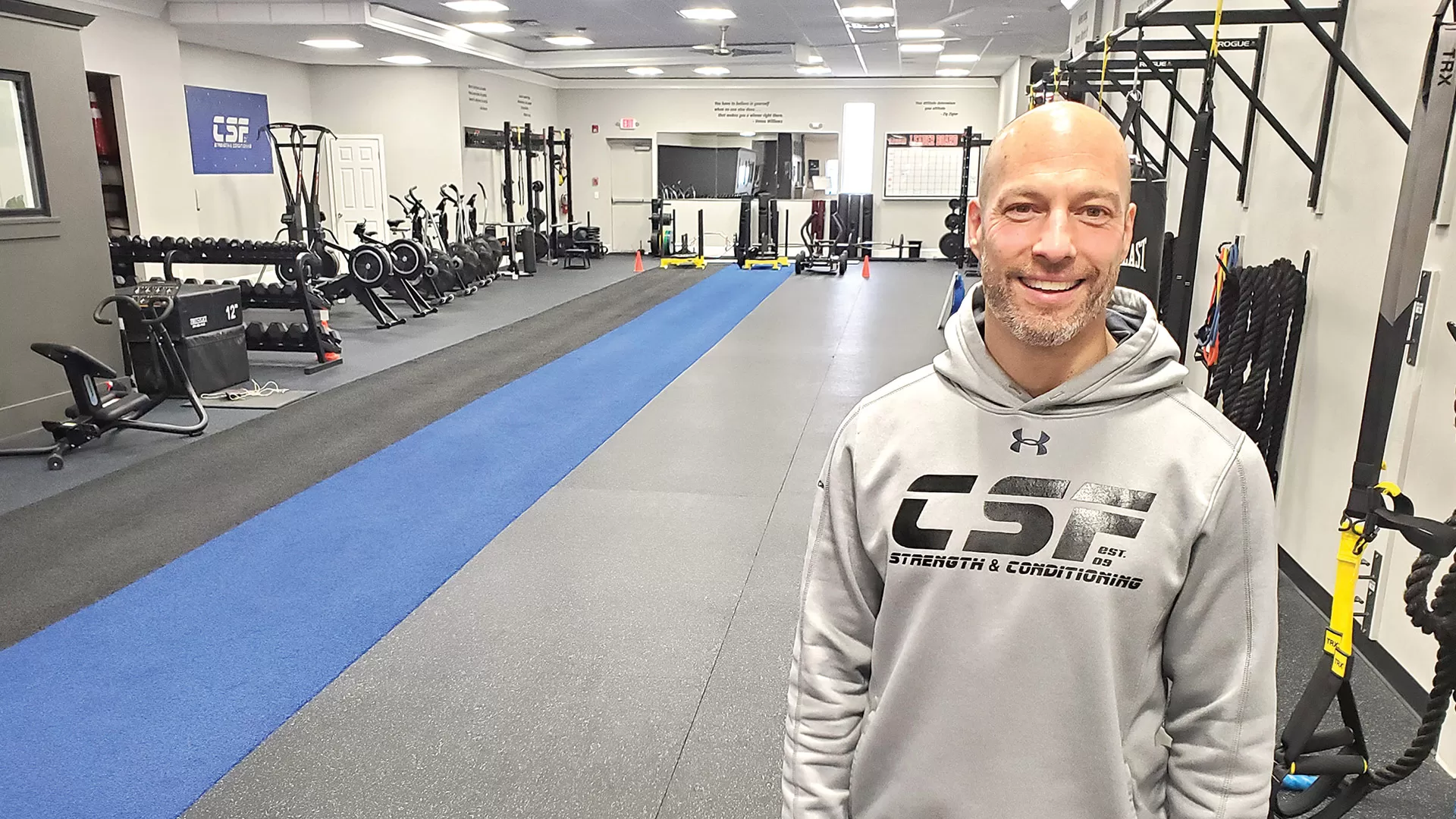One Workout at a Time
By Emily Thurlow

Steve Conca, owner of Conca Sport and Fitness
Between platefuls of coma-inducing turkey, complete with all the fixings, and palatable pies and pastries, it’s safe to say that many people are happy to see the hearty overindulgences of the 2023 holiday season firmly in the rear-view mirror.
For many, the start of the new year provides an opportunity to start out on the right foot, by developing better habits and establishing goals. Through myriad resolutions, one theme that tends to stand out year after year is health.
Notably, an October 2023 survey from Forbes Health/OnePoll revealed that 48% of U.S. adults say improving fitness is a top priority for them in 2024. Google Trends also released data showing that some of the top health-related searches in January include meal preparation, healthy meal ideas, and gym memberships.
And while some say they resolve to lose weight or improve their health in January, it often takes another month before they will deliver, said Danny Deane, who owns two local F45 Training franchises with his wife, Jessye.
“February is the number-one month in the fitness industry, with September being second,” he said. “In January, everybody starts to think about it, and then, by the time February rolls around, they’re really making good on their promise.”
Whether it’s during the winter doldrums or as the leaves begin to turn in the fall, local fitness studios and gyms continue to see positive gains in this post-pandemic climate — in both their business and their clients.
“I think people are realizing that putting an investment into themselves pays big dividends.”
“I think people are realizing that putting an investment into themselves pays big dividends,” said Steve Conca, owner of Conca Sport and Fitness in West Springfield.
During the pandemic, gyms and fitness centers were severely challenged by shutdowns and limitations on the amount of people in a space at any given time. For some, the impact was minimal. For others, it’s been rather extreme.

One key to success at gyms like F45 Training is accountability with a workout partner.
In fact, 25% of fitness studios and gyms have closed permanently since the onset of COVID-19, according the National Health & Fitness Alliance, an industry group.
However, Jon Davis, owner and performance director of Powerhouse Training in East Longmeadow, said business is “as good as it ever has been.”
Powerhouse Training, which Davis founded in 2010, offers sports-specific lessons for baseball and softball athletes as well as general performance training in speed, agility, strength, and mobility. The majority of his clientele includes athletes between age 8 and pro-rank levels.
Because Powerhouse Training provides more of a specialized kind of exercise regimen, Davis said he didn’t see the decline in attendance that many commercial gyms did. He said he’s also found that parents are valuing their children’s access to being physically active.
“I think a lot of parents realize the importance of having their kids get outside and socialize and stay active, for not only their physical health, but also their mental health,” he told BusinessWest. “Since we provide more of a specialized training, the kids really can’t train on their own, and they need assistance as well as special equipment, and they need a lot more space. So I think we were a necessity for them, which has certainly helped out.”
The group training, which involves youth athletes coming in two to three times a week, costs between $145 and $195 per month. Prices range between $50 and $90 for baseball lessons and $50 and $75 for fitness training.
Investing in Health
For the most part, Conca’s entire membership stuck with his gym. He expressed gratitude for the tight-knit community, or “family,” that is Conca Sport and Fitness, which first opened in 2009.
For months, all the personal training and small-group training was done outside. Unlike more recent weather patterns, the forecast remained relatively sunny, with little precipitation. And once the clouds of the pandemic restrictions cleared, he actually saw a slight resurgence.
“People are always going to want the newest, latest, and greatest thing — and, certainly, some of those innovations are really helpful — but honestly, I think learning good form and focusing on staying balanced, working mobility, and strength training will never get old.”
“I think it’s opened people’s eyes to realize, ‘I really wasn’t taking great care of myself,’ so it’s led them to want to invest in themselves,” he said. “Here, we call investing in yourself a health savings account. The more you can put in now, the more you can reap the benefits.”
In addition to personal training and group training, Conca Sport and Fitness also offers health nutrition and wellness coaching. Memberships range between $209 to $349 a month, with individual sessions ranging between $20 to $37.
“When people come here, they aren’t just going to bang out a few workouts, high-five, fist-bump, and ‘see ya later,’” he said. “It’s a whole process that includes teaching people how to take better care of themselves as they age.”
As for the Deanes, the couple, who opened their first gym, F45 Training Hampshire Meadows in Hadley in 2018, decided to open a second location in West Springfield in 2020.
“A lot of doors closed throughout the last couple years in the fitness world, but we are lucky enough to be on the other side of it and are actually above pre-COVID numbers at Hampshire Meadows,” Danny said. “We made it through.”
The 45 in F45 stands for 45 minutes of functional fitness, with sessions led by two personal trainers in a motivating team environment, said Jessye Deane, who is also executive director of the Franklin County Chamber of Commerce and Regional Tourism Council.

F45 Training does not employ heavy equipment or machinery, but it does include the use of kettlebells, free weights, and body-weight-based movements.
“The goal is really functional fitness. It’s scalable and adaptable, so it fits every fitness level,” she said. “A lot of times, what we hear is that folks go to the gym and want to get healthier, want to be able to move better, and want to be able to feel better, but they don’t quite know how to work the machines or they don’t know what they’re doing, and they get hurt, or they get frustrated. And this is kind of the answer to that. All you have to do is walk through the door, and we will take it from there.”
Every day, the gym features a different workout. F45 Training does not incorporate heavy equipment or machinery, but it does include the use of kettlebells, free weights, and body-weight-based movements.
The workouts for the Australian-based franchise combine elements of high-intensity interval training, circuit training, and functional training. The West Springfield location also currently offers a free seven-day trial, and the Hadley location is offering a seven days for $7 offer.
Trends come and go, but according to the area gym owners BusinessWest spoke with, having a healthier lifestyle comes down to the basics.
“People are always going to want the newest, latest, and greatest thing — and, certainly, some of those innovations are really helpful — but honestly, I think learning good form and focusing on staying balanced, working mobility, and strength training will never get old,” Davis said. “I think those tend to produce the best results.”
Conca agreed, noting that, as people age, he explained, they lose strength, muscle mass and function.
“Father time just begins chipping away,” Conca said. “That’s why maintaining muscle mass and strength levels — the fundamentals — is super important. I’d argue that it’s more important than so-called cardio, because you can get a good cardiovascular response with some very good strength training.”
According to the National Institutes of Health, muscle mass decreases approximately 3% to 8% per decade after age 30. After age 60, the rate of decline is even higher.
While F45 workouts have the adaptability to pull in emerging trends, Jessye Deane emphasized that trends are not the mainstay of the gym.
“We want you to feel great now, and we want you to feel great in 20 years — that’s our motivator,” she said. “The focus of our programming is to make sure that we’re providing people the safest, most effective functional fitness workout they can have.”
One way F45 workouts tap into recent trends is through supersets, she added. A superset includes performing a set of two different exercises back to back with little to no rest in between. One example of this would be doing a set of 10 push-ups, followed immediately by pull-ups.
Sticking with It
Finding motivation to stick with any new habit can be difficult, of course. It can potentially be even harder when the only opportunity to dedicate time to fitness is before the sun rises or well after it sinks below the horizon. That time crunch, combined with inclement winter weather, can make someone want to shed their new goal before they even begin.
One way Conca and the Deanes have seen clients stick with their fitness routines is by not doing it alone.
“Accountability is key. Having a group of people that you’re excited to see every day helps,” Jessye Deane said, adding that her husband is her workout partner. “Danny is my accountability partner. He wakes me up every morning whether I want to or not.”
At Powerhouse, Davis coaches each athlete differently based on their personality. Some kids may require more positive affirmation to help build their confidence, while others require him to be blunt and upfront and tell them directly what they’re doing incorrectly.
“It’s getting to know these athletes — getting to know what they like, what they don’t like, what motivates them, and then trying to find out what makes them tick and make sure that, when it’s time to push, we know what button to push,” he explained.
Throughout his tenure, Davis has produced more than 100 All-Western Mass. high-school all-stars, 13 All-Americans at the high-school and collegiate levels, and three Western Mass. Players of the Year in football, baseball, and girls lacrosse. He’s also helped produce 10 Major League Baseball draft picks out of the high-school ranks, including Isan Díaz and Seamus Curran.
At Conca’s gym, motivational phrases festoon the walls, including quotes from famous folks ranging from Wayne Gretzky to Amelia Earhart. The gym also features a so-called ‘strong wall’ that includes one-word motivational phrases that clients create to help drive their personal success. At the time of this interview, Conca was still tinkering with the specifics of the acronym LIFT, with the goal of lifting others up.
For those looking to dip their toe into the fitness and exercise pool, Jessye Deane said anytime is a good time to start.
“There is nothing more important than your health,” she told BusinessWest. “Whether you’re working out at an F45 or you’re doing yoga or you’re visiting any of the wonderful studios in the Valley, we really want people just to feel better and be healthier.”
“Where residents live in Massachusetts should not determine their mobility or access to opportunity.”




 Massachusetts has created various public programs for certain diverse business enterprises to address this issue, such as the state’s certification program through the Supplier Diversity Office (SDO).
Massachusetts has created various public programs for certain diverse business enterprises to address this issue, such as the state’s certification program through the Supplier Diversity Office (SDO). “Outsourcing your business’s accounting function provides considerable benefits beyond number crunching. It allows owners to devote more time and resources to core business functions like strategic growth and nurturing customer relationships, which are crucial for long-term success.”
“Outsourcing your business’s accounting function provides considerable benefits beyond number crunching. It allows owners to devote more time and resources to core business functions like strategic growth and nurturing customer relationships, which are crucial for long-term success.”

 “Standard deduction amounts for 2024 have been inflation-adjusted and are higher than they were last year.”
“Standard deduction amounts for 2024 have been inflation-adjusted and are higher than they were last year.”


 A UMass Amherst sleep scientist, funded with $6.7 million in grants from the National Institutes of Health (NIH), has launched two unprecedented studies that will track over time the brain development of infants and preschoolers to confirm the role of napping in early life and to identify the bioregulatory mechanisms involved.
A UMass Amherst sleep scientist, funded with $6.7 million in grants from the National Institutes of Health (NIH), has launched two unprecedented studies that will track over time the brain development of infants and preschoolers to confirm the role of napping in early life and to identify the bioregulatory mechanisms involved.











 “As planners, these changes often prompt investigating alternative ways to pass on wealth earlier to heirs, including layering in additional diversification with investments spread between retirement accounts, Roth IRA/401(k) plans, and non-retirement assets.”
“As planners, these changes often prompt investigating alternative ways to pass on wealth earlier to heirs, including layering in additional diversification with investments spread between retirement accounts, Roth IRA/401(k) plans, and non-retirement assets.”



 “Many people today do not have access to pensions like the generation before us. So that means investing early and wisely is paramount to building the wealth needed to achieve your retirement dreams.”
“Many people today do not have access to pensions like the generation before us. So that means investing early and wisely is paramount to building the wealth needed to achieve your retirement dreams.”








 “Generally, anti-harassment training is a helpful addition the employer’s tool chest for preventive measures against discrimination and harassment.”
“Generally, anti-harassment training is a helpful addition the employer’s tool chest for preventive measures against discrimination and harassment.”

 Last month, the U.S. Department of Labor (DOL) issued a final rule that provides businesses with guidance to be used when evaluating whether a worker should be classified as an employee or an independent contractor under the Fair Labor Standards Act (FLSA). The DOL is also expected to issue a final rule that will extend overtime protections to an estimated 3.6 million salaried workers who are currently exempt under the law. Read on for more details about both of these developments.
Last month, the U.S. Department of Labor (DOL) issued a final rule that provides businesses with guidance to be used when evaluating whether a worker should be classified as an employee or an independent contractor under the Fair Labor Standards Act (FLSA). The DOL is also expected to issue a final rule that will extend overtime protections to an estimated 3.6 million salaried workers who are currently exempt under the law. Read on for more details about both of these developments.

 “One of the core components of this legislation includes an increase in the child tax credit, a move set to benefit families with children across the nation. This concept is further strengthened by the introduction of a refundable portion determined per child, a clear advantage for growing families.”
“One of the core components of this legislation includes an increase in the child tax credit, a move set to benefit families with children across the nation. This concept is further strengthened by the introduction of a refundable portion determined per child, a clear advantage for growing families.”















